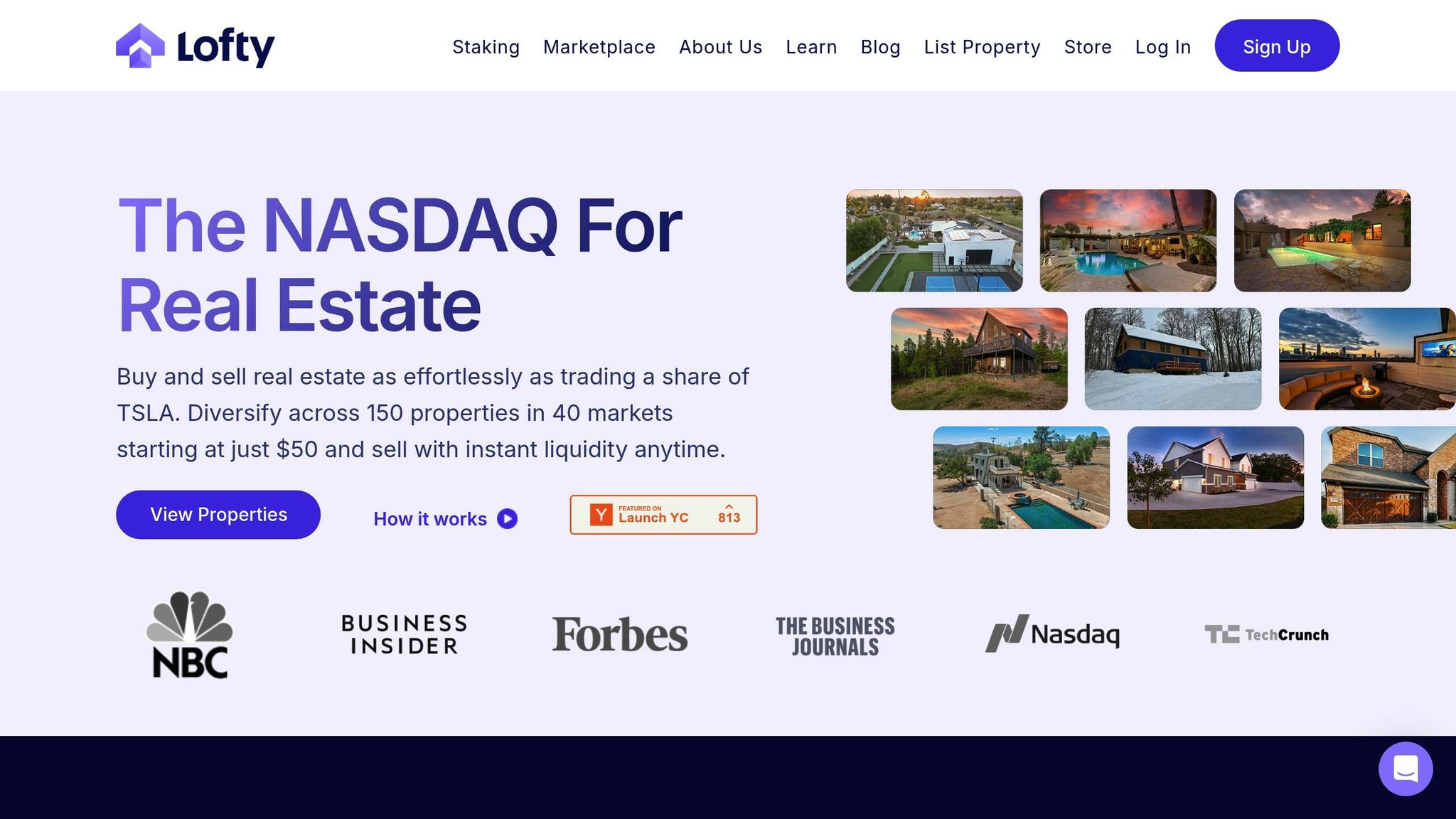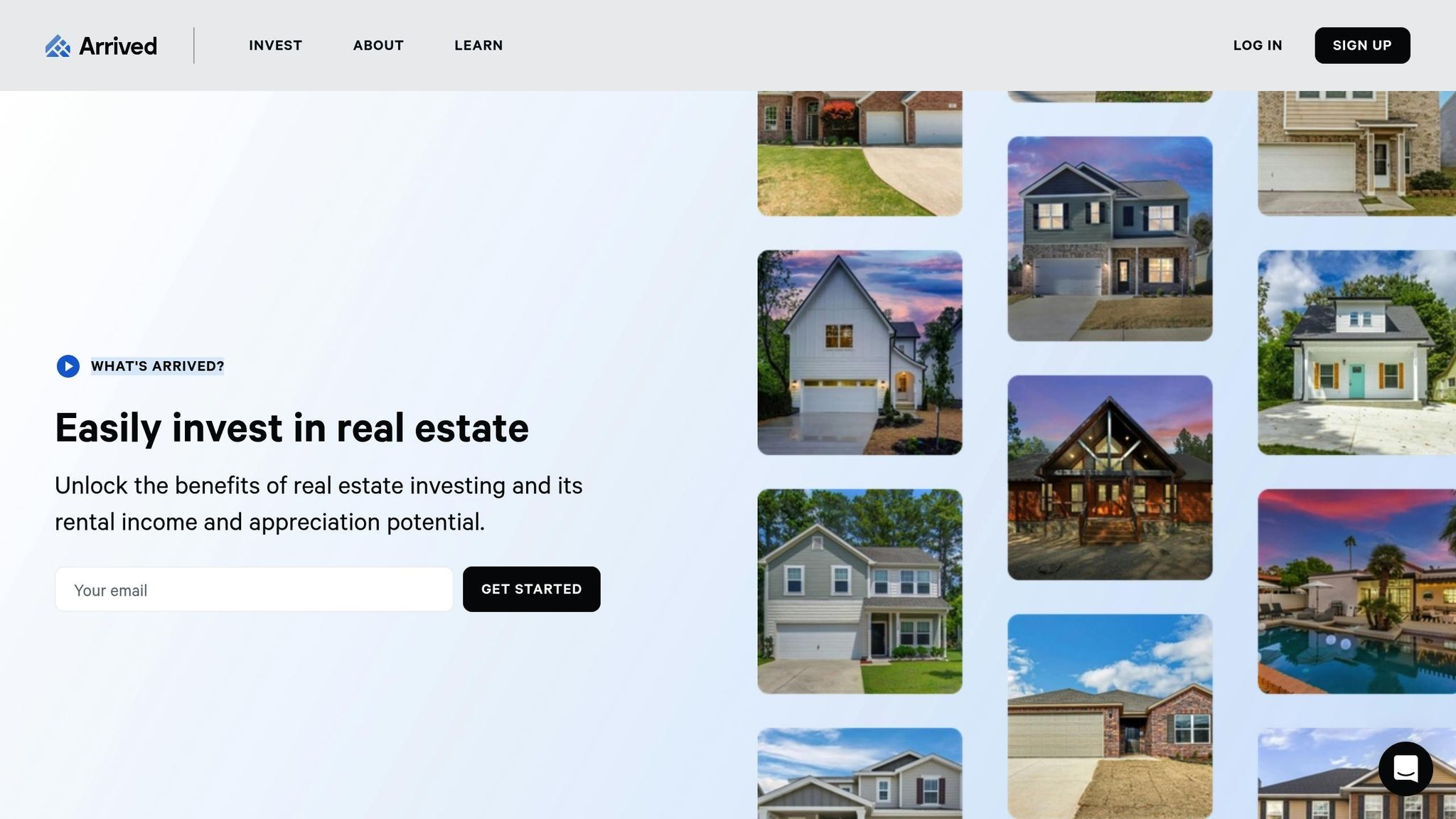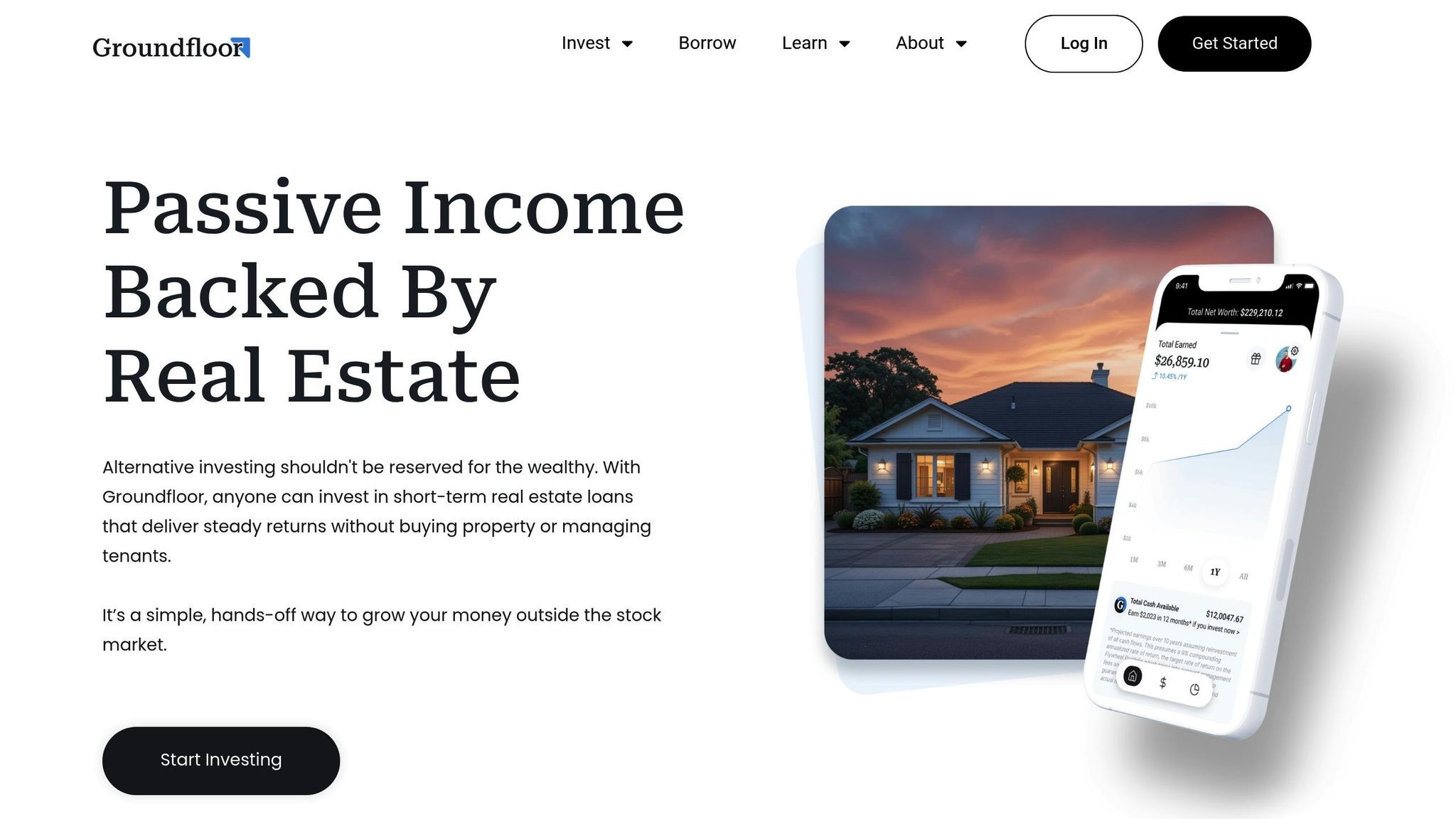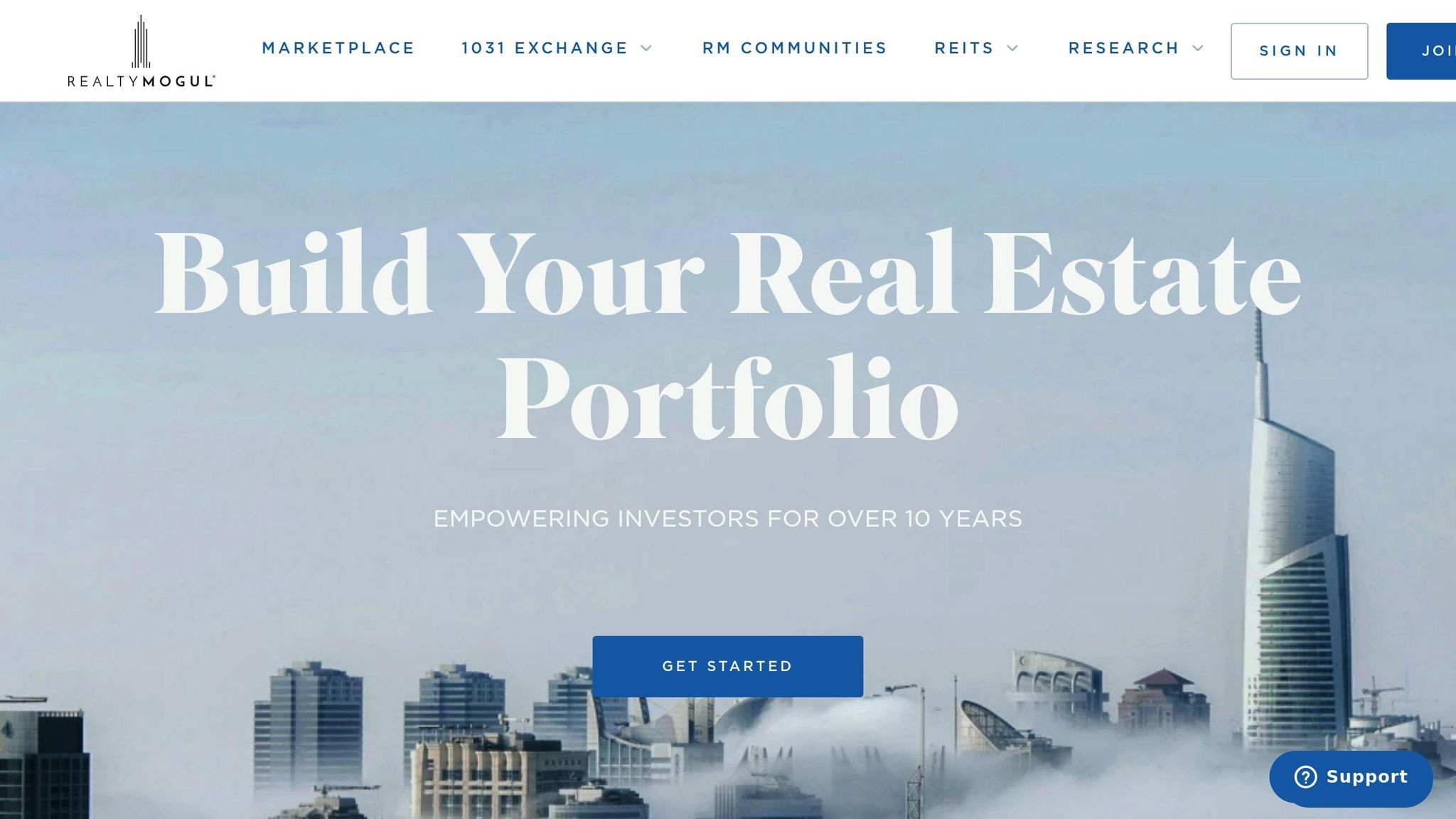5 Best Platforms for $100 Real Estate Investments
Jerry Chu
Investing in real estate no longer requires tens of thousands of dollars or dealing with the hassle of property management. Thanks to fractional real estate platforms, you can now start with as little as $100 and earn passive income through rental properties or property appreciation. These platforms pool funds from multiple investors, making real estate accessible to everyone, including non-accredited investors.
Here are the top 5 platforms for fractional real estate investments:
- Lofty: Start with $50. Offers tokenized real estate shares and daily rental income with no minimum holding period.
- Arrived: Minimum $100. Focuses on rental homes and vacation properties, with consistent quarterly dividends.
- Fundrise: Invest from $10. Provides a diverse portfolio of residential, multifamily, and industrial properties.
- Groundfloor: Start at $10. Specializes in short-term real estate loans, offering quicker liquidity compared to others.
- RealtyMogul: Minimum $5,000. Targets higher-net-worth investors with REITs and direct property investments.
Quick Comparison
| Platform | Minimum Investment | Key Feature | Liquidity Options |
|---|---|---|---|
| Lofty | $50 | Blockchain-based, daily income | No minimum holding period |
| Arrived | $100 | Rental homes, vacation properties | Quarterly Secondary Market Transactions |
| Fundrise | $10 | Broad real estate portfolio | Quarterly redemption program |
| Groundfloor | $10 | Short-term real estate loans | Shorter investment timelines |
| RealtyMogul | $5,000 | REITs and high-value properties | Limited liquidity for REITs |
These platforms let you diversify your investments while earning passive income. However, be mindful of fees, holding periods, and risks like market fluctuations or property vacancies. Start small, research thoroughly, and build your portfolio over time.
How to Invest in Real Estate With Just $100 (Beginner's Guide)
What to Know About $100 Real Estate Investments
Fractional property ownership has made real estate investing more accessible, turning what was once a high-barrier asset into an option for everyday investors. Instead of purchasing an entire property, you own a small fraction of a rental property, sharing both the benefits and risks with other investors.
Through crowdfunding platforms, funds from multiple investors are pooled together to purchase properties. Rental income and any increases in property value are then distributed proportionally. These platforms operate using various structures, such as REITs (Real Estate Investment Trusts), SPVs (Special Purpose Vehicles), or even tokenized shares, allowing you to invest in real estate without needing to buy a whole property.
When considering fractional real estate investments, a few key factors will help guide your decisions. Minimum investment amounts typically range from $100 to $500, though some platforms offer entry points as low as $10. The types of properties available vary widely - some platforms focus on single-family rental homes, while others include commercial spaces, apartment complexes, or mixed-use developments.
Investor eligibility has become more inclusive since the JOBS Act, opening up opportunities to non-accredited investors. However, certain high-end deals may still require accredited investor status. The geographic focus of platforms also plays a role; some target specific regions like the Southeast or West Coast, while others provide options across the U.S.
Liquidity is a crucial consideration. Unlike stocks, which you can sell anytime, fractional real estate investments often require longer holding periods. Some platforms offer secondary markets where you can sell your shares to other investors, but these markets may have limited activity. In many cases, you’ll need to hold your investment until the property itself is sold, which could take anywhere from 3 to 7 years or longer.
Fees are another important aspect to evaluate, as they directly affect your returns. Common fees include acquisition fees (usually 1-3% of the property purchase price), annual management fees (typically 0.5-2% of your investment), and disposition fees when properties are sold (often 1-3% of the sale proceeds). Some platforms also charge transaction fees for buying or selling shares.
Your returns come from two main sources: rental income and property appreciation. Rental yields typically range between 4-8% annually, with payments made monthly or quarterly, depending on the platform. Property appreciation varies based on market conditions and property performance but has historically averaged 3-5% annually in many U.S. markets.
Regulatory requirements add another layer to the process. These platforms must follow SEC regulations, unless they are not selling securities, which include detailed disclosures and investor protections. While this ensures safety, it can also mean a slower start - your first investment might take a few days to complete as the platform verifies your identity and financial details.
Tax considerations for fractional real estate closely resemble those of traditional property ownership. You’ll receive tax documents that report your share of rental income, which is taxable. On the upside, you may be able to use depreciation deductions to offset some of this income. When a property is sold, any gains are typically treated as capital gains, though the specifics depend on how long you held the investment and your overall tax situation.
Understanding these basics can help you compare platforms effectively and start building a balanced fractional real estate portfolio.
1. Lofty

Lofty is a blockchain-powered platform that makes fractional real estate investing possible. By using tokenization, the platform divides properties into digital shares, making it easier for investors to own a piece of rental properties across the United States. This modern approach creates an accessible and competitive investment option.
Minimum Investment
Lofty has a low barrier to entry. Any investor can start with just $50 per share for new property offerings. On Lofty's secondary marketplace, shares are available for at a variety of market prices.
Investor Eligibility
The platform caters to both accredited and non-accredited investors, offering investment thresholds that align with different financial goals and capabilities.
Property Types Offered
Lofty focuses on rental properties in various U.S. markets, prioritizing areas with strong rental demand and growth potential.
Liquidity and Holding Periods
One of Lofty’s standout features is its liquidity. There’s no minimum holding period, meaning investors can sell their shares immediately after purchase. Shares can be listed for sale on Lofty’s secondary marketplace, where orders are held in escrow for up to 30 days. Proceeds from sales are paid in USDCa, which must be converted to U.S. dollars through a crypto exchange.
"The huge difference that sets Lofty apart from most real estate crowdfunding websites is its secondary market, letting you buy and sell shares at any time. That addresses one of the greatest drawbacks when you invest in rental properties: the lack of liquidity."
- G. Brian Davis, SparkRental
Income Potential
Lofty provides daily rental income distributions, so investors receive regular earnings based on their ownership share. In addition to rental income, investors may benefit from property appreciation, with token holders collectively deciding when to sell the property.
Fee Structure
Lofty charges a 3.5% transaction fee on sell orders placed through its marketplace. Additionally, transactions on the Algorand blockchain incur a minimal fee of 0.001 ALGO (around $0.0002).
While the blockchain integration offers flexibility, converting cryptocurrency to dollars might be a bit challenging for those unfamiliar with digital finance.
2. Arrived

Arrived, inspired by platforms like Lofty, offers a fresh way to invest in fractional real estate. With 731,000 registered users and over $240 million invested in 440+ properties across 63 markets, it’s clear they maintain high standards - only 0.2% of reviewed homes make the cut .
Minimum Investment
You can get started with as little as $100 per property or fund.
Investor Eligibility
Arrived welcomes both accredited and non-accredited investors.
Property Types Offered
Arrived provides a variety of investment opportunities, including individual rental homes, vacation properties, and specialized funds like the Single Family Residential Fund, City Funds, and the Private Credit Fund. The Private Credit Fund alone has grown to $32.6 million in net assets as of March 2025.
Liquidity and Holding Periods
Liquidity depends on the type of investment. Single-family homes typically have holding periods of 5–7 years, while vacation rentals range from 5–15 years. The Single Family Residential Fund has a six-month lockout period. Additionally, a secondary market set to launch in Summer 2025 could allow for earlier exits .
Income Potential
Arrived has delivered consistent returns, paying over $12 million in dividends so far. Performance highlights for Q4 2024 include:
- 4.0% annualized dividend for single-family residential investments
- 18.60% average total return across 173 sold properties
- 11.98% average appreciation
Investors benefit from quarterly dividends as well as property appreciation.
Fee Structure
Here’s a breakdown of the fees associated with different investments:
- Long-term rentals: 3.5% sourcing fee, 0.15% quarterly asset management fee, and 8% property management fee on gross rental income.
- Vacation rentals: 5% sourcing fee, 5% gross rents fee, and 15–25% property management fee depending on the market.
- Single Family Residential Fund: 0.25% quarterly asset management fee and 3.5% sourcing fee on new properties.
- Private Credit Fund: 0.10% monthly asset management fee.
- Early redemption fees: 2.0% during the first year and 1.0% between years one and five.
Arrived’s fee structure is transparent, allowing investors to plan accordingly based on their chosen properties or funds.
3. Fundrise
Fundrise stands out as one of the top real estate crowdfunding platforms, even ranking among the 50 largest private equity investors worldwide. It offers a more accessible way to invest in real estate, requiring lower minimum investments compared to traditional property purchases. Here's a closer look at what makes Fundrise unique.
Property Types Offered
Fundrise boasts a diverse portfolio that spans several real estate sectors, including residential, multifamily, and industrial properties in high-growth U.S. markets. For example, its current holdings include 3,471 single-family homes spread across 30 markets in the U.S. and 8,962 residential units in multifamily apartment complexes across 10 markets. On the industrial side, Fundrise manages 2,310,800 square feet of leasable space.
"Our portfolio aims to harness the most powerful long-term macroeconomic drivers of the U.S. economy. Trends like increased demand for well-located residential assets across the sunbelt to the explosion of eCommerce-driven industrial spaces."
- Fundrise Real Estate Strategies, 2025
In addition to these property types, Fundrise also gives investors access to private credit (real estate loans) and venture capital through specialized funds. This variety, paired with its structured approach to liquidity, caters to long-term investment strategies.
Liquidity and Holding Periods
Investments through Fundrise generally require a holding period of at least five years. While these investments are largely illiquid, the platform does offer a share repurchase program to provide some liquidity. For funds like the Flagship Fund, Income Fund, Innovation Fund, and eREITs, liquidation requests are reviewed on a quarterly basis. These are processed on a first-in, first-out (FIFO) basis, though redemptions may occasionally be suspended or adjusted depending on Fundrise’s policies.
Income Potential
The Flagship Real Estate Fund, which focuses on build-for-rent communities, multifamily developments, and industrial properties in the Sunbelt region, has delivered an annualized return of 4.3% since its inception. Fundrise has shown a strong track record of navigating different market conditions effectively, making it a consistent performer in the real estate investment space.
sbb-itb-a24235f
4. Groundfloor

Groundfloor takes a different approach to real estate investing by concentrating on short-term real estate debt rather than direct property ownership. Instead of purchasing shares in properties, investors provide funding for loans secured by real estate projects, essentially stepping into the role of lenders for real estate developers.
Minimum Investment
Groundfloor offers flexible entry points for investors, including:
- Individual loans starting at just $10
- The Flywheel Portfolio with a $100 minimum
- Groundfloor Notes requiring $1,000
- IRA investments beginning at $25,000[32,33]
Property Types Offered
Groundfloor primarily funds residential projects through short-term loans. These projects often include "fix and flip" ventures, where properties are purchased, renovated, and sold. Beyond house flipping, the platform supports new construction projects, refinance-rehab loans, and refinance-cash-out loans. This variety provides real estate developers with multiple financing options to suit their needs.
Liquidity and Holding Periods
One of Groundfloor’s standout features is its shorter investment timelines compared to traditional real estate investments. Most loans span several months to a few years, making it easier for investors to access their funds sooner. For those seeking consistent cash flow, the Flywheel Portfolio is structured to deliver planned liquidity. This flexibility contrasts sharply with the often long-term commitment required by other real estate investment models.
Income Potential
Groundfloor generates returns for investors through interest payments on the loans they fund. Borrowers pay regular interest, creating a steady income stream. The Flywheel Portfolio goes a step further by diversifying investments across multiple loans, aiming to deliver higher yields and more predictable returns.
5. RealtyMogul

RealtyMogul sets itself apart by catering to investors who are ready to commit more substantial amounts, rather than those looking for entry-level investments. The platform provides access to both REIT options and direct property investments, but its higher minimum investment requirements make it less accessible for those with smaller budgets.
Minimum Investment
Investing with RealtyMogul starts at $5,000 for its two primary REITs: the RealtyMogul Income REIT and the RealtyMogul Apartment Growth REIT. Additionally, there is a one-time setup fee of $1,000. The platform is open to both accredited and non-accredited investors, though non-accredited investors are limited to the REIT options at the $5,000 minimum.
For accredited investors interested in direct property investments, minimums are significantly higher, typically ranging from $25,000 to $35,000. Some opportunities even require up to $100,000. These higher thresholds underscore RealtyMogul's focus on investors with more experience or larger financial resources, setting it apart from platforms that allow much smaller investments.
Investor Eligibility
Accredited investors gain access to a wider array of opportunities, including those with higher minimum requirements, beyond the standard REIT offerings.
Platform Comparison Table
Minimum investment requirements can play a big role in deciding which platform suits your needs. Here's a quick comparison of the minimum investments across popular platforms:
| Platform | Minimum Investment |
|---|---|
| Lofty | $50 |
| Arrived | $100 |
| Fundrise | $10 for brokerage accounts; $1,000 for IRAs |
| Groundfloor | $100 general; $10 for Loans; $1,000 for Notes |
| RealtyMogul | $5,000 for REITs; $25,000-$100,000 for individual projects [21] |
The minimum investments vary quite a bit. Lofty has the lowest entry point at $50, making it highly accessible. Arrived follows with a $100 minimum. Fundrise stands out with its flexibility - $10 for standard brokerage accounts, though IRAs require a $1,000 minimum. Groundfloor offers even more options, starting at just $10 for specific loans, $100 generally, and $1,000 for Notes. On the higher end, RealtyMogul requires $5,000 for REITs and between $25,000 and $100,000 for individual projects.
Risks and Things to Consider
While investing $100 in real estate might sound appealing, it’s important to understand the potential risks that come with it.
Liquidity can be a challenge. Unlike stocks, which you can sell quickly during market hours, fractional real estate investments often lock your money in for longer periods. Some platforms enforce specific holding periods, while others may offer limited secondary markets for selling your shares. This means your $100 might not be readily available when you need it.
Platform fees can eat into your returns. Management fees typically range from 0.5% to 2.5% annually, with additional charges for property management, transactions, or even early withdrawals. For a $100 investment, a 1% annual fee translates to $1 off your returns before you see any profit. These fees can add up, especially with smaller investments.
Individual properties come with their own risks. Maintenance issues, vacancies, or local market downturns can directly impact your returns. For instance, a major repair or a prolonged vacancy could wipe out months of rental income, making it harder to achieve steady profits - even if other properties in your portfolio perform well.
Market fluctuations are another factor to consider. Real estate values can drop, as seen during the 2008 financial crisis. While diversifying across multiple properties can help reduce risk, it doesn’t eliminate it entirely.
You’ll have limited control over decisions. When you invest through a platform, you’re relying on its managers to make key decisions - like which properties to buy, how to manage them, and when to sell. This hands-off approach means you can’t directly influence crucial choices, even if market conditions change.
Taxes can get complicated. Fractional real estate investments often come with K-1 forms, which can make tax filing more complex and may require professional help - an added expense to consider.
To navigate these risks, do your homework. Research platform reputations, fee structures, and exit options carefully. Start with small investments and spread your money across different platforms and properties to minimize risk and gain experience.
Keep in mind, real estate investing is a long-term game. It’s not about quick returns but about building a solid foundation for a larger portfolio over time. With patience, research, and realistic expectations, even a $100 investment can be a stepping stone toward your financial goals.
Conclusion
Fractional real estate investments are breaking down the traditional barriers that made real estate investing seem out of reach for anyone without significant financial resources. With platforms now offering starting investments as low as $10 or $100, building a diverse real estate portfolio no longer requires massive down payments or dealing with the hassles of property management.
These platforms make it simple to diversify your investments while tapping into the strong performance trends seen across the real estate industry. They offer opportunities to earn passive income and benefit from property appreciation, all with accessible entry points and easy-to-use interfaces. Whether you’re interested in Lofty’s instant liquidity, Fundrise’s broad investment options starting at just $10, or Arrived’s focus on rental properties with a $100 minimum, there’s something for every type of investor.
To succeed in fractional real estate investing, it’s essential to do your homework. Take time to compare each platform’s fee structure, property offerings, and liquidity features to ensure they align with your financial goals and risk tolerance. Since most investments have holding periods of 5 to 7 years, be prepared for a longer-term commitment before diving in.
Even a modest $100 investment can be the starting point for building a larger real estate portfolio. Many investors begin small, gain confidence as they see steady returns, and increase their investments over time. This approach makes real estate investing more accessible than ever, opening the door for anyone to participate in this traditionally exclusive market.
FAQs
What is fractional real estate investing, and how can you get started with just $100?
Fractional real estate investing lets you buy small shares of a property, giving you a portion of its rental income and any future value growth. The best part? You don’t need a huge upfront investment - some platforms let you start with as little as $100, making real estate an option for nearly anyone.
This method comes with plenty of perks. You can spread your investment across multiple properties and markets, reducing risk while building a more diverse portfolio. Plus, it’s a great way to earn passive income and step into real estate without needing deep expertise or hands-on involvement.
What should I look for in a fractional real estate platform, and how do fees affect my returns?
When choosing a fractional real estate platform, there are a few key factors to weigh: platform fees, property selection, liquidity, management approach, and transparency. Each of these can have a big impact on your investment experience and potential returns.
For example, fees - whether they’re management fees or transaction costs - directly affect your bottom line. While lower fees might seem like a win, they can sometimes come with trade-offs, such as reduced liquidity or limitations on long-term performance. That’s why it’s crucial to dig into the fee structure and make sure it aligns with what you’re aiming to achieve with your investment.
What are the potential risks of fractional real estate investing, and how can I reduce them while growing my portfolio?
Fractional real estate investing isn’t without its challenges. Some of the key risks include limited control over how properties are managed, liquidity issues when trying to sell your shares, and market fluctuations that can impact property values. These factors can influence both your returns and how easily you can manage your investments.
To navigate these risks, it’s crucial to take a proactive approach. Start by researching properties and investment platforms thoroughly to ensure they align with your goals. Diversify your portfolio by investing in different types of properties and across various locations. Staying updated on market trends and understanding tenant behavior can also give you an edge. By building a well-rounded portfolio and staying informed, you’ll be better equipped to handle potential challenges and make smarter investment decisions.
Related Blog Posts


